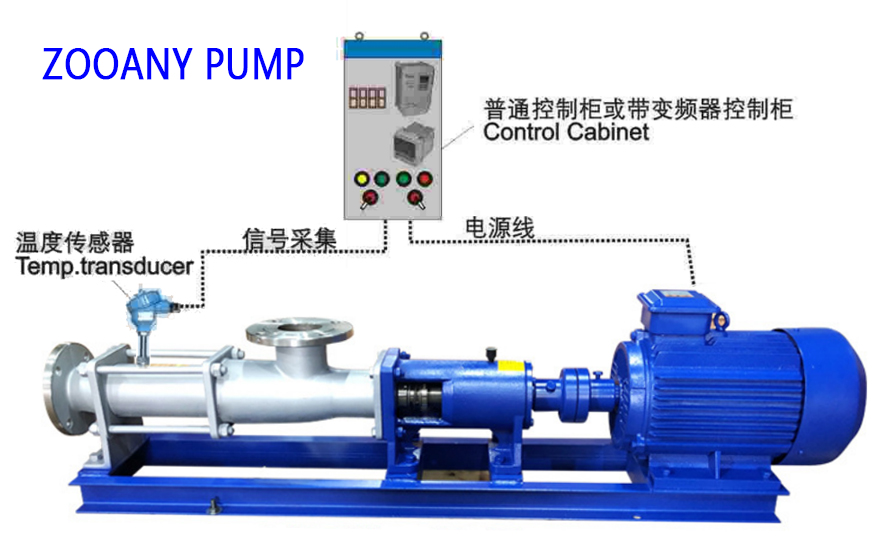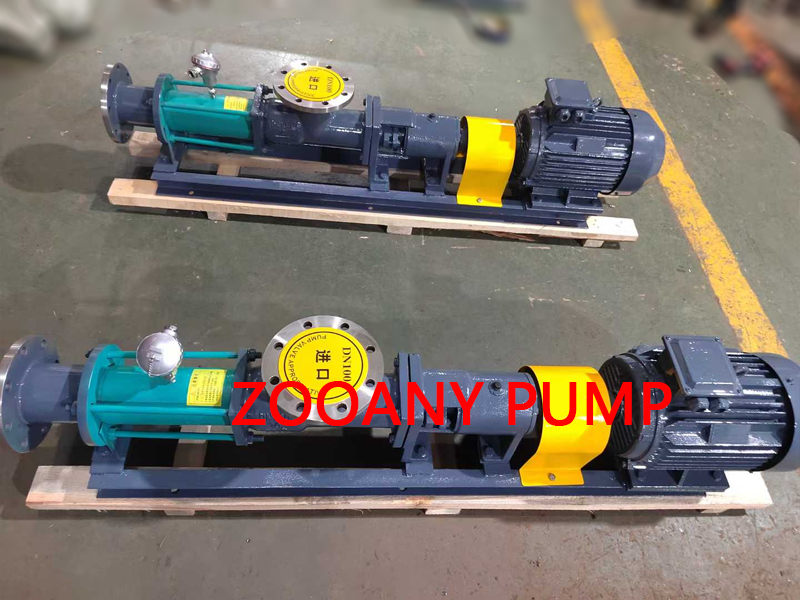When the pump experiences dry operation, the contact surface between the stator and rotor will rapidly heat up. When the temperature reaches the set temperature limit, the dry operation protector will automatically shut down and issue an alarm signal. Often used in situations where the medium has poor fluidity and is prone to material breakage.

How to avoid dry running of screw pumps during operation?
Screw pump dry running refers to operating without conveying medium, which can seriously affect the performance and service life of the pump, and even cause equipment damage. To prevent the screw pump from running dry during operation, measures can be taken in terms of design, installation, operation, maintenance, and monitoring alarms.
Design installation level
Reasonable system design: When designing the entire fluid delivery system, it is important to ensure sufficient medium supply to avoid dry running caused by insufficient medium supply. For example, design a suitable storage tank capacity and ensure smooth pipeline connection between the storage tank and the screw pump to avoid air resistance or blockage. At the same time, plan the pipeline layout reasonably, minimize unnecessary bends and valves, reduce fluid flow resistance, and ensure that the medium can smoothly enter the screw pump.

Install anti dry running device: Install a liquid level sensor at the inlet of the screw pump. When the liquid level is below the set value, the sensor will send a signal to trigger relevant protective devices, such as automatically cutting off the power or starting the backup pump, to prevent the screw pump from running dry. In addition, a flow switch can be installed to automatically stop the operation of the pump when the flow rate is detected to be zero. A temperature sensor can also be installed to automatically stop the operation when the stator temperature rises abnormally. These anti dry running devices can monitor the operating status of the pump in real time and take timely measures to avoid dry running.
In terms of operation and usage
Pre start inspection: A comprehensive inspection must be conducted before starting the screw pump each time. Firstly, check if the liquid level in the storage tank is sufficient to ensure there is enough medium available for transportation. At the same time, check whether the pipeline system is connected correctly and whether the valves are in the correct open or closed state to avoid the medium from entering the pump body due to valve misoperation. In addition, it is necessary to check whether there are any blockages in the inlet and outlet pipelines of the pump. If there are blockages, they should be cleaned in a timely manner to ensure that the medium can pass through smoothly.
Correct start and stop sequence: Strictly follow the operating procedures for start and stop operations. When starting, the inlet valve should be opened first to fill the pump body with the medium, and then the motor should be started to ensure that the pump starts running with the medium. When stopping the pump, the motor should be turned off first, and then the inlet and outlet valves should be closed to prevent the medium from flowing back and causing the pump to reverse or dry. During the start-up and shutdown process, it is important to closely monitor the operating status of the pump. If there are any abnormal situations, the operation should be stopped immediately and checked.
Operator training: Provide professional training to operators to familiarize them with the working principles, operating procedures, and precautions of screw pumps. The training content should include how to correctly judge the operating status of the pump, how to handle common faults, and how to avoid dry running and other issues. Through training, improve the skill level and safety awareness of operators, ensure that they can correctly operate and maintain screw pumps, and reduce dry running caused by human error.
Maintenance perspective
Regular maintenance and inspection: Establish a regular maintenance and inspection system to comprehensively inspect and maintain the screw pump. The inspection includes the sealing performance of the pump, the wear of the bearings, and the damage of the impeller. By regularly maintaining and inspecting, potential problems can be identified and resolved in a timely manner to ensure the normal operation of the pump. For example, regularly check whether there is any leakage in the seals, and if there is any leakage, replace the seals in a timely manner; Check the lubrication condition of the bearings to ensure good lubrication and reduce wear.
Cleaning and unclogging pipelines: Regularly clean and unclog the pipelines connected to the screw pump to prevent impurities, dirt, and other contaminants from blocking the pipelines and affecting the flow of the medium. When cleaning pipelines, professional pipeline cleaning equipment such as high-pressure water guns, pipeline dredging machines, etc. can be used. At the same time, installing a filter at the inlet of the pipeline can filter out impurities in the medium, protect the screw pump from damage caused by impurities, and also help avoid dry running caused by pipeline blockage.

Monitoring and alarm measures
Real time monitoring of operating parameters: Utilizing advanced monitoring technology to monitor the operating parameters of screw pumps in real-time, such as flow rate, pressure, temperature, etc. By monitoring the changes in these parameters, abnormal operation of the pump can be detected in a timely manner. For example, when the flow suddenly decreases, the pressure abnormally increases, or the temperature rises, it may be due to the pump running dry or other faults, and corresponding measures should be taken immediately for handling.
Contact: NEIL
Phone: 86-18205509969
E-mail: 18205509969@139.com
Add: 118, Building 3, Tianrun City Phase II, Tianchang City, Anhui Province. China